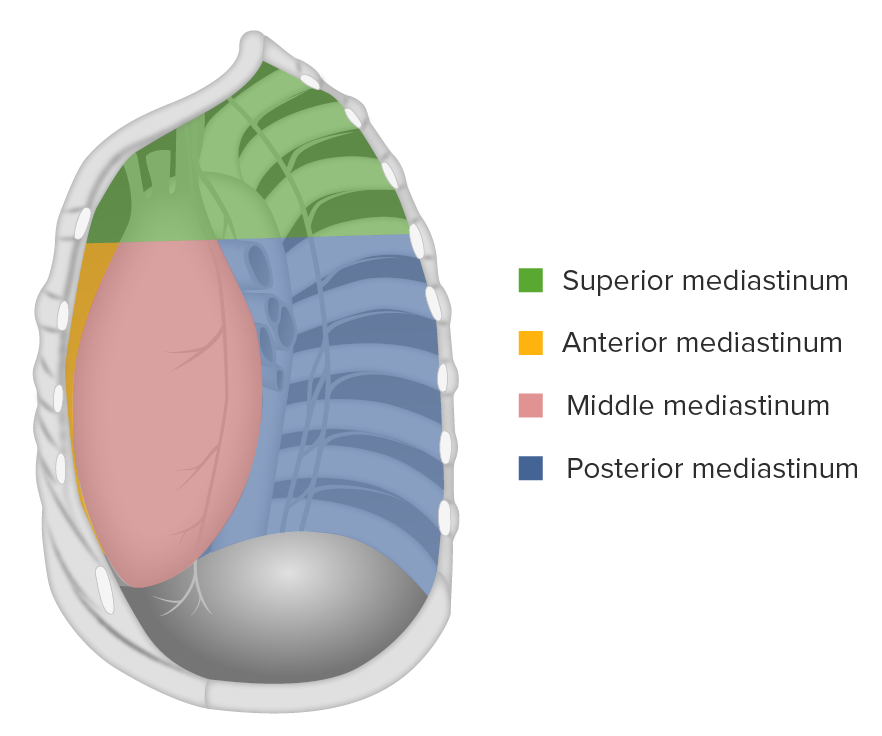Playlist
Show Playlist
Hide Playlist
Great Vessels of the Thorax
-
Slides Anatomy Great Vessels of the Thorax.pdf
-
Download Lecture Overview
00:01 As great as the heart is, it wouldn't be much good to us without some great vessels connecting it to the rest of the circulatory system. 00:07 So let's take a look at these great vessels that attach to the heart. 00:12 We'll start with the superior vena cava, which drains deoxygenated blood from the upper half of the body. 00:18 We see we have a right internal jugular vein, draining the head and neck. 00:22 And we have a right subclavian vein draining the right upper limb. 00:26 And together they'll form the right brachiocephalic vein. 00:30 Brachiocephalic refers to upper limb and head. 00:34 And finally that will enter into the SVC. 00:38 It's variable but usually, the right inferior thyroid veins are also going to drain into the brachiocephalic right before it goes into the SVC. 00:48 Similarly, on the left side, we have a left internal jugular vein, we have a left subclavian vein, and they'll form the left brachiocephalic vein, which is quite a bit longer than the right because it has to cross over the midline to reach the SVC over on the right side of the heart. 01:06 It also tends to receive the inferior thyroid veins on that side before joining the SVC. 01:12 And although wasn't pictured on the right side, the brachiocephalic also tend to receive the internal thoracic or mammary veins. 01:20 If we remove the veins, we can see our aortic arch a lot better. 01:25 So here we have our aortic arch. 01:27 And this first very large branch we see something called the Brachiocephalic trunk. 01:33 And as the name implies, it's going to supply the upper limb, and head and neck. 01:37 And so it will branch into a right common carotid artery supplying the head and neck, and a right subclavian artery supplying the upper limb. 01:46 And here's where we have a bit of a symmetry because the left common carotid and left subclavian arteries arise directly from the arch. 01:55 Therefore, there is no left brachiocephalic trunk. 01:59 There's just the one. 02:01 And the subclavian has some notable branches that are descriptive in their names, including thyrocervical, costoscervical, and vertebral. 02:12 They basically tell you what they're going to supply. 02:14 And we've already seen that the internal thoracic or mammary arteries arise from the subclavian. 02:20 Now, let's take a look from the left side where we can see our ascending aorta becoming an arch the aortic arch. 02:28 And then finally, posteriorly becoming the descending aorta as it heads towards the abdomen. 02:33 And it's going to go through that hiatus. 02:36 The aortic hiatus in the diaphragm in order to reach the abdominal cavity. 02:41 Go back to an anterior view. And we're going to remove the aorta to see the pulmonary trunk, and its branches better. 02:49 We see the pulmonary trunk is pretty short before it branches into the right and left main pulmonary arteries. 02:56 And if we swing around to the left, we can see it again. 02:59 With again a very short trunk forming almost a T shaped intersection where it bifurcates into the left and right pulmonary arteries. 03:07 Here we see the left pulmonary artery coming right at us and towards the hilum of the lung. 03:13 We also see a tiny bit of connective tissue between the pulmonary trunk and aorta called the ligamentum arteriosum. 03:20 Which if you recall from fetal circulation is the leftover remnants of that fetal bypass called the ductus arteriosus. 03:29 And it's connecting again to the aortic arch, which in this case, we see that it's going over the right pulmonary artery before moving leftward, to cross over the left main bronchus. 03:43 And this is what we mean when we say an arch is a left sided arch or a leftward arch. 03:49 When you learn about congenital heart diseases, you'll hear that term and a left sided arch is the more common arrangement. 03:57 But you might hear the term right sided arch. 03:59 And in that case, it will cross over the right main bronchus.
About the Lecture
The lecture Great Vessels of the Thorax by Darren Salmi, MD, MS is from the course Thorax Anatomy.
Included Quiz Questions
Where do the right inferior thyroid veins drain?
- Right brachiocephalic vein
- Right internal jugular vein
- Right internal subclavian vein
- Left internal jugular vein
- Left internal subclavian vein
Which arteries usually branch directly off the aortic arch?
- Brachiocephalic trunk, left common carotid, left subclavian
- Right subclavian, left common carotid, right common carotid
- Left subclavian, right common carotid, right subclavian
- Left subclavian, left common carotid, right common carotid
- Left brachiocephalic trunk, right common carotid, right subclavian
Customer reviews
5,0 of 5 stars
| 5 Stars |
|
5 |
| 4 Stars |
|
0 |
| 3 Stars |
|
0 |
| 2 Stars |
|
0 |
| 1 Star |
|
0 |




